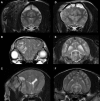Prognostic value of early magnetic resonance imaging in dogs after traumatic brain injury: 50 cases
- PMID: 24814522
- PMCID: PMC4857941
- DOI: 10.1111/jvim.12368
Prognostic value of early magnetic resonance imaging in dogs after traumatic brain injury: 50 cases
Abstract
Background: The prognostic value of early magnetic resonance imaging (MRI) in dogs after traumatic brain injury (TBI) remains unclear.
Objectives: Determine whether MRI findings are associated with prognosis after TBI in dogs.
Animals: Fifty client-owned dogs.
Methods: Retrospective study of dogs with TBI that underwent 1.5T MRI within 14 days after head trauma. MRI evaluators were blinded to the clinical presentation, and all images were scored based on an MRI grading system (Grade I [normal brain parenchyma] to Grade VI [bilateral lesions affecting the brainstem with or without any lesions of lesser grade]). Skull fractures, percentage of intraparenchymal lesions, degree of midline shift, and type of brain herniation were evaluated. MGCS was assessed at presentation. The presence of seizures was recorded. Outcome was assessed at 48 h (alive or dead) and at 3, 6, 12, and 24 months after TBI.
Results: Sixty-six percent of the dogs had abnormal MRI findings. MRI grade was negatively correlated (P < .001) with MGCS. A significant negative correlation of MRI grade, degree of midline shift, and percentage of intraparenchymal lesions with follow-up scores was identified. The MGCS was lower in dogs with brain herniation (P = .0191). Follow-up scores were significantly lower in dogs that had brain herniation or skull fractures. The possibility of having seizures was associated with higher percentage of intraparenchymal lesions (P = 0.0054) and 10% developed PTE.
Conclusions and clinical importance: Significant associations exist between MRI findings and prognosis in dogs with TBI. MRI can help to predict prognosis in dogs with TBI.
Keywords: Dogs; MRI; Prognostic; Traumatic brain injury.
Copyright © 2014 by the American College of Veterinary Internal Medicine.
Figures




Similar articles
-
Early CT in dogs following traumatic brain injury has limited value in predicting short-term prognosis.Vet Radiol Ultrasound. 2021 Mar;62(2):181-189. doi: 10.1111/vru.12933. Epub 2020 Nov 26. Vet Radiol Ultrasound. 2021. PMID: 33241888
-
Evaluating traumatic brain injury using conventional magnetic resonance imaging and susceptibility-weighted imaging in dogs.J Vet Sci. 2019 Mar;20(2):e10. doi: 10.4142/jvs.2019.20.e10. Epub 2019 Mar 14. J Vet Sci. 2019. PMID: 30944533 Free PMC article.
-
Prognostic Significance of Magnetic Resonance Imaging in Detecting Diffuse Axonal Injuries: Analysis of Outcomes and Review of Literature.Neurol India. 2022 Nov-Dec;70(6):2371-2377. doi: 10.4103/0028-3886.364066. Neurol India. 2022. PMID: 36537418 Review.
-
[The prognostic value of mri-classification of traumatic brain lesions level and localization depending on neuroimaging timing].Zh Vopr Neirokhir Im N N Burdenko. 2019;83(4):46-55. doi: 10.17116/neiro20198304146. Zh Vopr Neirokhir Im N N Burdenko. 2019. PMID: 31577269 Russian.
-
Imaging assessment of traumatic brain injury.Postgrad Med J. 2016 Jan;92(1083):41-50. doi: 10.1136/postgradmedj-2014-133211. Epub 2015 Nov 30. Postgrad Med J. 2016. PMID: 26621823 Review.
Cited by
-
A Review of Medical Conditions and Behavioral Problems in Dogs and Cats.Animals (Basel). 2019 Dec 12;9(12):1133. doi: 10.3390/ani9121133. Animals (Basel). 2019. PMID: 31842492 Free PMC article. Review.
-
Hemorrhagic encephalopathies and myelopathies in dogs and cats: a focus on classification.Front Vet Sci. 2024 Oct 28;11:1460568. doi: 10.3389/fvets.2024.1460568. eCollection 2024. Front Vet Sci. 2024. PMID: 39529855 Free PMC article. Review.
-
Agreement of Magnetic Resonance Imaging With Computed Tomography in the Assessment for Acute Skull Fractures in a Canine and Feline Cadaver Model.Front Vet Sci. 2021 Apr 22;8:603775. doi: 10.3389/fvets.2021.603775. eCollection 2021. Front Vet Sci. 2021. PMID: 33969028 Free PMC article.
-
2-Hydroxyglutaric aciduria as a cause for seizure-like episodes in a domestic shorthair cat.JFMS Open Rep. 2019 Jun 18;5(1):2055116919853898. doi: 10.1177/2055116919853898. eCollection 2019 Jan-Jun. JFMS Open Rep. 2019. PMID: 31245020 Free PMC article.
-
Neurological functional evaluation based on accurate motions in big animals with traumatic brain injury.Neural Regen Res. 2019 Jun;14(6):991-996. doi: 10.4103/1673-5374.250578. Neural Regen Res. 2019. PMID: 30762010 Free PMC article.
References
-
- Management of Concussion/mTBI Working Group . VA/DoD clinical practice guideline for management of concussion/mild traumatic brain injury. J Rehabil Res Dev 2009;46:1–68. - PubMed
-
- Simpson SA, Syring R, Otto CM. Severe blunt trauma in dogs: 235 cases (1997‐2003). J Vet Emerg Crit Care (San Antonio) 2009;19:588–602. - PubMed
-
- Shores A. Craniocerebral trauma In: Kirk RW, ed. Current Veterinary Therapy X. Philadelphia, PA: WB Saunders; 1983:847–854.
-
- Platt SR, Radaelli ST, McDonnell JJ. The prognostic value of the modified Glasgow Coma Scale in head trauma in dogs. J Vet Intern Med 2001;15:581–584. - PubMed
-
- Lowenstein DH. Epilepsy after head injury: An overview. Epilepsia 2009;50(Suppl 2):4–9. - PubMed
MeSH terms
LinkOut - more resources
Full Text Sources
Other Literature Sources

